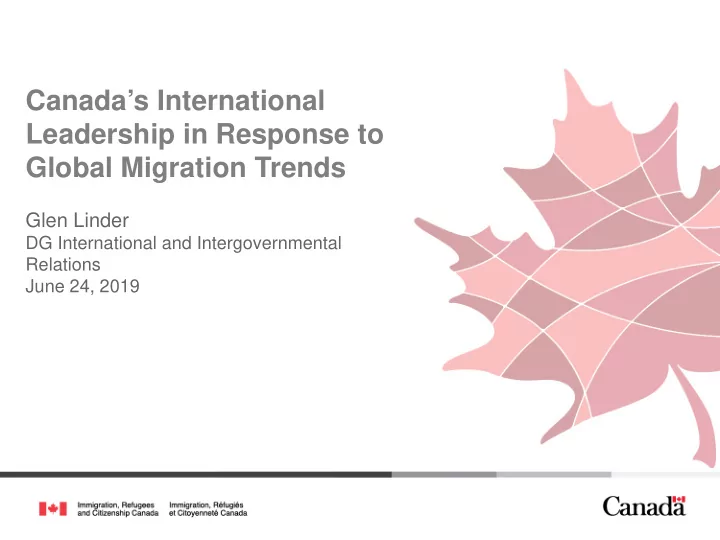

Canada’s International Leadership in Response to Global Migration Trends Glen Linder DG International and Intergovernmental Relations June 24, 2019
Glob obal al m migr gration f flows a are increa easing ( g (and c changi ging). Since 2000, the total number of international migrants has increased by almost 50 percent , from 173 million people in 2000 to 258 million people in 2017 1 . Migration is also increasing relative to the global population growth ; with migrants representing 2.8% of the global population in 2000 compared to 3.4% in 2017 2 . 70.8 million people worldwide had been forcibly displaced as of 2018 – the highest number in history 3 . Adapting to a Changing World Canada’s geographic position has kept it relatively isolated from irregular migration flows. New trends however have prompted Canada to adapt to the changing landscape of migration. Evolving Patterns Why are people moving? Migration drivers include economic opportunities, While most migration occurs regionally and follows technology and social media as information safe, orderly and regular pathways, migration source exposing new opportunities and access, patterns are changing. Regional migration in the political instability, humanitarian crises and Americas has increased, as has migration within the conflict, natural disasters and climate change. Global South. 2 2 (1) Source: UN Department of Economic and Social Affairs (UN DESA); (2) Source: UN DESA; (3) Source: UNHCR
These ese tren ends ha s have e a domesti tic i impact. t. • Canada’s managed migration system is respected around the world, but volumes, those seeking to exploit the system, and irregular migration are impacting effective management and service delivery. • Canada is increasingly a country of destination - migration to Canada is rising . Permanent Residents* Protected Persons and Refugees Asylum Claimants 2015 271, 816 32,113 16,055 Syrian Refugee 2016 296,346 58,912 23,870 Initiative 2017 286,479 41,475 50,390 2018 321,055 45,750 55,035 These trends have led Canada to: Work closely with bilateral partners and through multilateral forums to ensure a • well-managed international border, and ensure migration occurs safely, and through regular channels. • Remain globally competitive, attracting international students and skilled labour. • Push for greater global cooperation on international migration management and refugee protection. 3 *Below numbers include ‘Protected Persons and Refugees’
What i is the e role of i inter ernati tional en engagement? t? International engagement helps reap the benefits of migration and address the challenges that come with mixed migration and evolving migratory patterns and to advance Canadian priorities and objectives . Canada engages with international partners and key countries to promote regular migration pathways, mitigate challenges to our system, strengthen refugee protection, and share best practices. Key Multilateral Why Engage? Partners Well managed migration contributes economically and socially to Canada. Well managed migration in the hemisphere contributes to security within the North American perimeter . Capacity building can help to discourage irregular migration and promote regular pathways by funding: research, training seminars, technical expertise and pilot pathway projects. Engagement provides opportunities to influence the directions of collaborative responses to global challenges, 5 and of the international discourse on migration.
How i Ho w is Canada engagi aging i g internation onal ally? y? • Canada engages in dozens of bilateral meetings with other countries at all levels on the full scope of migration related issues. • With over 60 IRCC Missions around the world, Canada’s presence is felt globally on the ground, providing an opportunity for face-to-face engagement and exchange. • Canada is the 2019-2020 chair of the Intergovernmental Consultations on Migration, Asylum and Refugees and the Migration 5 . • Canada plays a strong and constructive role in the International Organization for Migration (IOM), the United Nations High Commissioner for Refugees , and other multilateral bodies where migration issues arise • Canada actively participated in the development of and adopted both the Global Compact for Safe, Orderly and Regular Migration (GCM) and Global Compact for Refugees (GCR) in December 2018. • Launched in 2017, and based off Canada’s Private Sponsorship of Refugees Program, the Global Refugee Sponsorship Initiative works to open new pathways for refugees. GRSI partners have actively engaged with numerous countries, of which six have launched or are soon launching programs. • IRCC’s Migration Policy Development Program is funding capacity-building projects around the world to advance international policy development. 6
Questions? 7
Recommend
More recommend